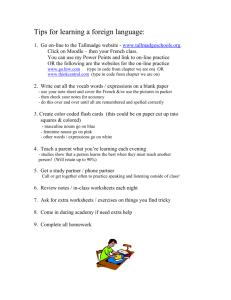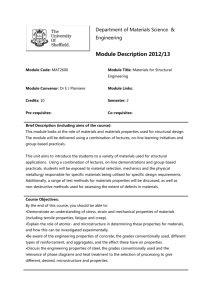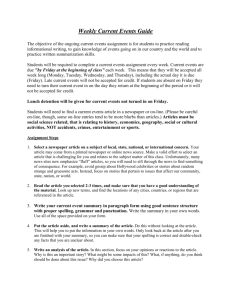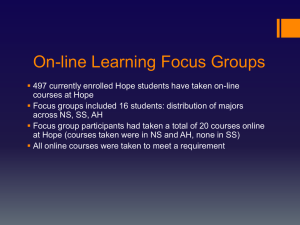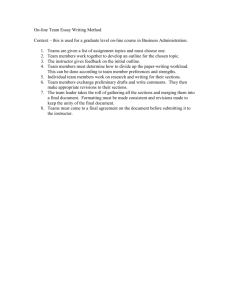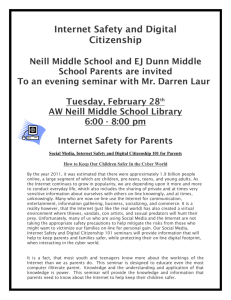Article1 - Physics - Buffalo State College
advertisement
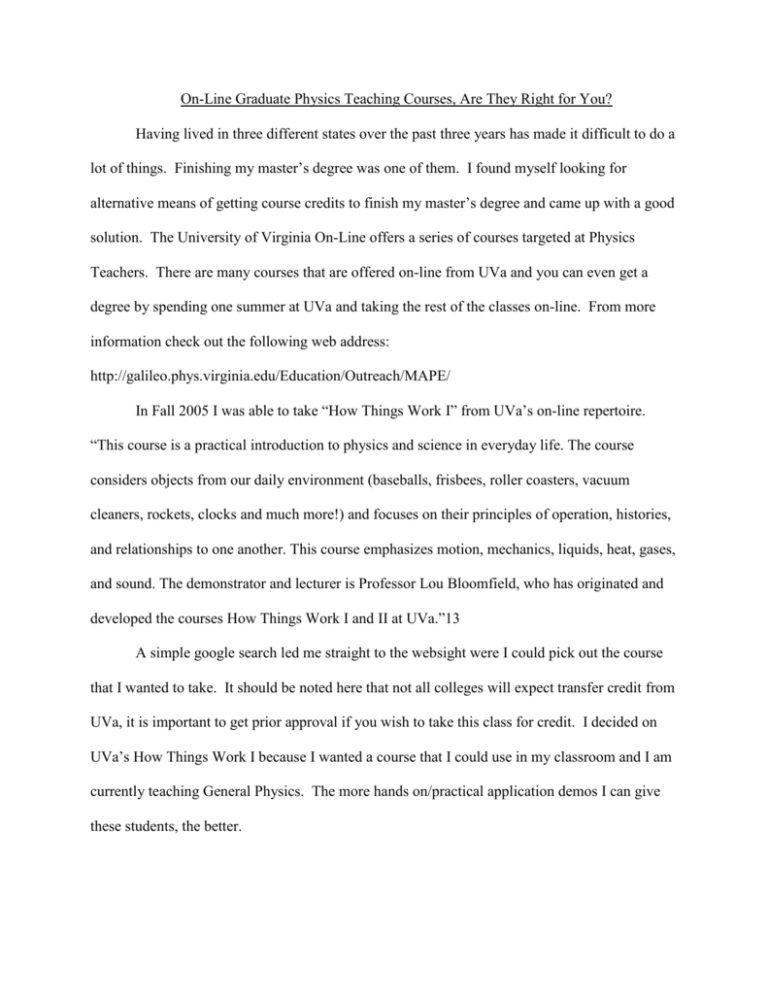
On-Line Graduate Physics Teaching Courses, Are They Right for You? Having lived in three different states over the past three years has made it difficult to do a lot of things. Finishing my master’s degree was one of them. I found myself looking for alternative means of getting course credits to finish my master’s degree and came up with a good solution. The University of Virginia On-Line offers a series of courses targeted at Physics Teachers. There are many courses that are offered on-line from UVa and you can even get a degree by spending one summer at UVa and taking the rest of the classes on-line. From more information check out the following web address: http://galileo.phys.virginia.edu/Education/Outreach/MAPE/ In Fall 2005 I was able to take “How Things Work I” from UVa’s on-line repertoire. “This course is a practical introduction to physics and science in everyday life. The course considers objects from our daily environment (baseballs, frisbees, roller coasters, vacuum cleaners, rockets, clocks and much more!) and focuses on their principles of operation, histories, and relationships to one another. This course emphasizes motion, mechanics, liquids, heat, gases, and sound. The demonstrator and lecturer is Professor Lou Bloomfield, who has originated and developed the courses How Things Work I and II at UVa.”13 A simple google search led me straight to the websight were I could pick out the course that I wanted to take. It should be noted here that not all colleges will expect transfer credit from UVa, it is important to get prior approval if you wish to take this class for credit. I decided on UVa’s How Things Work I because I wanted a course that I could use in my classroom and I am currently teaching General Physics. The more hands on/practical application demos I can give these students, the better. Registering for the class was simple. Once I found the UVa’s webpage I was able to browse the courses that they offered and after reading the description, I picked the course I wanted to register for. There were links on the main web page that connected me to each course’s web page, and from there it was easy to find registration instructions. The course was a bit pricey for out of state students. My 3 credit hour course ended up costing me $937 plus the cost of a book. For this price I received access to the webpage and web assign, the program used to turn in and grade all assignments and tests. I also received 10 discs that were copied lectures of Professor Louis Bloomfield’s introductory Physics course for nonmajors. My CD’s arrived promptly in the mail and I was able to begin watching the CD’s with plenty of time before the course started. Some students were not so lucky and received their CD’s late. I am assuming that they registered late for the course. They had to use only the textbook for the first few homework assignments. At first I was leery of taking an on-line course. I’m literate with computer’s but that’s about it. If I have to install something I usually call re-enforcements, but I found the instructions for operating this course to be fairly straight forward, only providing a few glitches along the way. The following requirements were necessary to take this on-line course. You needed a computer with internet access, an e-mail account, some sort of media player on your computer for the CD’s and the ability to read and follow directions. Not only are instructions to get to everything else you need for the course available on the course web page, the instructor made sure that he e-mailed separate, more detailed log on instructions to each student. The only program that I needed to download was the Horizon Wimba Chat Room. This program allows you to have a conversation with your fellow classmates and teacher on a weekly basis. I had some difficulty getting this program to load properly and one week the system was down and no one could log on. This was the biggest head ache I had as far as technology goes. The Horizon Wimba Chat room was not required for the course, but it was nice to get to have some verbal conversations with classmates and the professor. In order to be able to properly use this technology you needed speakers and a microphone for you computer. The chat rooms were poorly attended with at most 7 people showing up out of ******. This lead to much frustration on the part of the teacher. At one point I was the only student in attendence. The chatrooms were held on Wednesday’s Nights at 8pm. The material was challenging for students who did not have a Physics background, and relatively simple for those students who did have a Physics background. I was able to do the first assignment without reading the book or watching the videos. (I did this anyway) However the later topics of Fluid Mechanics and Heat I have had relatively little experience in, and I found that I learned a great deal conceptually from these classes. The classes on the CD’s were at a very elementary level, in fact I found them to be rather boring, so I ended up doing other things like laundry, dishes, grading papers, etc. while I watched the videos. It was nice that I could do such things guilt free, where as bringing your laundry to lecture and folding it would be considered rude, it was perfectly acceptable to my computer. The homework questions were mostly all conceptual based, with a few simple calculations. I found writing up the answers to the conceptual based questions challenging, but not stressful. Have to write all of your answers out required much deeper thought than to explain an idea to someone. I found this helped me solidify the concepts in my head. You weren’t completely alone in trying to answer the questions. The professor was able to help out in the Chat Room every Wednesday, and you could post questions to your fellow students and the instructor on blackboard. The good side to this is that you could read and reread the responses that you were given. The down side is that sometimes no one responded to you and it took a day or two get a response. This means that completing your homework at the last minute left you with little to no help on your assignment. Your only hope was that someone more responsible asked the same questions you had. There were on average three hours worth of lectures to watch a week, plus about 50 pages of reading. Since homework was due every other week. I ended up watching six 45 minute lectures while reading the book Saturday and Sunday. (The homework was due on Monday or Tuesday usually.) If I would space things out more it wouldn’t have been quite so stressful. There were three multiple-choice exams given. For each exam you needed to find a proctor that would verify that you weren’t using notes during the exam. This had to be someone who was a professional relation of yours. After each exam you were asked to have your proctor e-mail you a statement saying “I concur” meaning that you didn’t do anything that would be considered cheating and then you had to cut and paste that message into the blackboard discussion link. The exams were very different from the homework, which made them a bit challenging, but not in a good way. To my thinking exams should try to capture what a student knows about a certain topic. There should be a set list of objectives for the student to accomplish, the homework should reflect these objectives and it should be mirrored by the exams. However on several occasions, topics or ideas that weren’t discussed in the homework were asked about on tests. Also some test questions served the purpose, not of testing knowledge, but of testing to see if students watched the lectures and did the required reading. Students were expected to memorize formulas for tests, but were not told which formulas to memorize. The professor for this course was very strict about grading and would not change grades if a question was worded poorly. For example I was asked what forces were acting on an inner tube moving at a constant speed down a river. My answer was gravity pushing down on the tube and a buoyant force pushing up. I was told this answer was incorrect and I should have replied that there were no forces acting on the tube. I should have known that the professor meant net force. The third exams I really enjoyed doing. Instead of taking an exam over the Thanksgiving Holiday, I was asked to write an exam with 15 multiple choice questions. The grading rubric was very well defined and I learned a lot trying to make up interesting and tricky questions. I felt this assignment really tested each student’s understanding of the material and not just tested trivial facts that the students may or may not have learned. The lectures did provide many interesting demonstrations, some of which I have already used in my classroom. One such example was a demonstration of tying a banana to a string and hanging it from the ceiling. You can then cut through the Banana with a knife using Newton’s first law to explain this concept. My students really enjoyed this demostration and it helped engage them. I am also planning on using some of Professor Bloomfield’s lectures on Fluids in my General Physics class to help explain and spark discussion. Any Graduate class that I can turn around in use in my classroom later that week was well worth the time spent taking it, and I would recommend this course even if you are not interested in getting graduate credit for this very reason. In today’s modern fast paced society, computers and technology are everywhere. Everyone from the budding new student teacher to the 30-year veteran teacher are scrambling to prove to their administrators and parents that they are technologically savvy. Internet and distance learning classrooms are popping up in high schools and universities all over the country. While there are many advantages to having an internet class, there are some setbacks as well. After taking two on-line courses, PHY 605: How Things Work I from the University of Virginia (Uva), and PHY 500 Physics Education Seminar from Buffalo State College, while completing my Masters Degree in Physics Education I have some insights to offer on the pros and cons of on-line learning. Originally I signed up to get my Master’s Degree at Buffalo State College. I had completed about one third of my master’s work and moved to Rochester, about an hour and a half away from Buffalo, and was worried about finishing my master’s program. Luckily, there were enough on-line classes offered to cause me to have to commute for only one class to finish my Masters Degree. The obvious pro of taking an on-line class for me was it would save me a lot of time traveling back and forth to class. While not all students who take on-line courses have to worry about living a prohibitive distance away from their school, a major advantage of on-line courses is that they do offer flexibility. I could do the lessons of the UVa class any time I wanted Students can do. While this requires students to be motivated and organized, and may not work for non-motivated students, it allows students to take Physics courses that normally would not be able to due to time constraints.11,4,7 This includes a growing number of college students who are also working full time, while going to school, or students with other responsibilities such as child care. The flexibility can also be a negative. Like many students I am a bit of a procrastinator. I found myself completing assignments closer and closer to the dead line as the course went on. Although there was always enough time to complete the assignments. One major advantage of completing the assignments on time was lost to me, I didn’t get a chance to discuss the problems with my peers. It usually takes between one and two days for a posted message to get answered, and when you are doing homework the night before no one has time to discuss problems with the homework. Relatively little information has been written on whether on-line teaching of physics course promotes just as much comprehension as a traditional lecture based course. In the letters to the editorial section of The Physics Teacher, James O’Connell asks this very question and invites colleagues to comment on the subject.2 Several teachers responded to O’Connell’s letter and offered some insight into his question. Nora Thornber, a teacher who is teaching a conceptual based physics course based on Paul Hewitt’s book says that she has been using WebCT to promote student discussion and feels that students benefit from the course because, “[the students] must participate, whereas in the classroom it is much easier to escape participation.” Not only do students need to be more motivated and self sufficient in order to pass a course where lectures are not given at a set time, the student must also participate in order to pass most on-line courses, where as in a lecture a student can sit in the back corner and never speak a word. Most professors find this aspect useful to helping their students learn physics concepts. While taking the How Things Work course I noticed that even though I was confident in answering some of the conceptual based questions, sitting down and writing a response caused me to think through my ideas more quickly. It forced me to be concise and careful in my wording. On-line courses may aid considerably in concept development of students. In-class discussion does not always allow for all voices to be heard. Also in most classrooms there are gender, race, income and other bias to contend with, a person’s voice might not be heard the same way coming from two different people. An earlier study of the a text based course on special and general relativity found similar benefits, saying that online dialog is “largely raceneutral, location-neutral, status-neutral, age-neutral, income-neutral, disability-neutral, and would be gender-neutral except for the clue of first names.”7 Nora Thornber notes that when students write out their comments it “:helps them to focus.”3 Smith and Taylor also agree to this benefit stating that forcing the students to comment on their learning “is a central advantage of computer conference courses.”7 A great example of how this worked to my disadvantage from the How Things Work course is the following. One a week our professor would use the Wimba Horizon Chat room to get some class discussion going. This chat room was horribly attended. Since attendence was not mandatory only about 1-4 other students were in the chat room at a time. One night I found myself, the professor and the Teaching Assistant were the only students in the chat room. I felt a little foolish since I didn’t really need any help with the material, but I asked the professor a bunch of questions anyway. He was nice enough to respond and then he ended the session with a series of open-ended questions. Horizon Wimba has a feature on it where all students in the chat room can anonymously post an answer to a question for the professor to read and discuss. This would have been great for me as a student since I was a bit of a wallflower, I usually had an idea of what was going on in class, but never answered any questions because I was too shy, if I could have anonymously reported my answers I would have participated more, but I digress. Anyway, the professor was asking the questions, so the teaching assistant and myself were answering the questions. The teaching assistant got two of the questions wrong and each time the professor assumed that I was the one with the wrong answers. A common program that many universities use to grade problem sets is Webassign, which allows professors to write their own questions and have a computer grade the answers. The Uva course used web-assign to grade all of their student’s responses. Although writing questions and programs is very time consuming the first time a teacher teaches the course, after several runs through the course, having a computer aid in grading cuts back on much of the grading time. The computer can also help by keeping a record of classroom participation, which makes this aspect much easier to grade. Using a computer program as a forum to a class also makes it easier to post messages and announcements, which may not get to everyone in a traditional lecture based course. I found all of these aspects helpful while taking my on-line course. Another thing I enjoyed is that I didn’t have to worry about misplacing my papers. Everything I wrote was graded electronically with the correct answers written underneath it even if got the question right. This provided me with much more insight as to what the teacher was looking for and I found it extremely helpful. Online instruction not only forces the instructor to be computer literate, it also forces students to be computer literate. While some courses, such at STCC require students to take a one credit computer orientation course, some courses, such as University of Virginia, online offer small tutorials that you are guided through to learn how to use all the necessary programs.11,7 I tend to be little on the computer illiterate side and was worried that if I got suck on a technical issue I would have problems completing assignments. I found the on-line instructions and tutorials to be more than adequet. Through the whole course I only got stuck on one technical issue. I had difficulty loading the Horizon Wimba program onto my computer. With a little help from a friend I was able to get it installed within a half an hour. In order to have a successful online discussion, the computers must be up, running and ready to transmit information. It is necessary for instructors to be able to receive work and give help to students who have PC’s or Macs.4 And instructors must also be able to smoothly handle any software that is used in the on-line course. Software out there to assist online courses is plentiful. Some claim that software such as WebCT has a steep learning curve3, while users of programs such as Horizon Wimba has reported that the program was very easy to use, all that was required was to run through a simple training program.8 This can also be one of the many disadvantages to an online course. Someone who has difficulty using the computer could easily be lost in an online course that they would thrive in if the course were lecture based.7 Answers to questions are not immediate and sometimes it takes several days before a question is answered in an online format, these are serious drawbacks. Another serious issue during online courses is the practice of flaming, or online aggression. Some people are much more critical of fellow classmates than they might otherwise be if they had to meet a person face to face. In Margaret Mazzonlini’s letter to the editor in The Physics Teacher she speculates that a reason few woman might participate in on-line listservs is due to flaming. Communicating through a computer makes emotions harder to read and phrases that could be softened by a smile in personal dialog, sound harsher than the speaker intended. It’s also easier to put others down when you are not talking with them in person. 1 A possible solution to this problem could be on-line audible conversations, but that also takes away from the flexibility in schedule. Other problems include self-motivation of students. If the whole course is online students must have enough discipline to set aside time every week to work on homework assignments.4 Professors have tried encourage students to work on homework assignments continuously by making postings to the list serve part of their grade. 3,7 Professors have also tackled this problem by chunking assignments into smaller pieces and requiring student to complete an assignment a day. Although interaction between students is made possible through chat rooms and online discussion forums such as Horizon Wimba, online course somewhat limit the amount of study that students could do together. Vygotsky’s social learning theory states that social interaction profoundly influences cognitive development, according to Vygotsky one can not learn without social interaction.6 Online classes limit the amount of give-and-take with your peers that a classroom provides, and may actually hinder student learning.4 Hands on-laboratory experiments pose another problem to students. There are two solutions to giving students a laboratory experience online.5 Some professors are using Java applets, and online computer simulations to have students collect data, while other professors have found inexpensive ways for students to complete their own labs using simple household materials.9 The UVa course that I took did not have a laboratory section with it, however it did have lectures with several very fun demonstation on it that we as students were asked to explain during tests. Although this did not give us the hands on experience of doing the labs/demonstrations by ourselves, it did force us to think about why things happen they way they do. This is a close second to being able to physically touch something. Some colleges, such as Springfield Technical Community College, are incorporating online Physics education and take-home labs as part of their introductory Physics course. They use Hands on Physics (HOP), a set of inquiry based Physics Labs that the students can take home and work on, to enhance their Physics curriculum. HOP was funded by the National Science Foundation and is being used in many colleges across the nation including MIT, Cal Tech, and Harvard.11 Another source of online laboratory experiments to go along with a conceptual based physics course is called Physics to Go, and was developed for the use in an online laboratory course at North Carolina Community College.12 Physics to Go is a kit of inexpensive items that when combined can be used for students to make their own laboratory experiments. Although the experiments are simple and cheap, it is often easy to confuse the simplest of directions, without a teacher, or fellow student there to supervise a lab set up, it is possible for students to set up lab equipment the wrong way and produce no results or no further conceptual knowledge. Online courses have many advantages, such as ease of grading, increase computer literacy, mandatory participation of students, flexibility in scheduling allowing a wider group of students to be able to take Physics, and instant feedback on problems being solved. However there are many draws backs as well. The amount of social interaction with other students and the professor are reduced, people who are not computer literate may become frustrated and forced to concentrate too much on learning computers instead of learning Physics. Some processes might take longer on a computer course such as typing in formulas. Also Physics students who take on-line courses must have a great deal of personal initiative in order to stay on top of assignments. I found my on-line class to be both mentally taxing and rewarding. I feel the program was set up in such a way that I was able to learn and re-enforce many physics concepts that I can now take to my physics teaching. 1. “Where are the Women? In response to Dan MacIssaac’s article [Phys. Teach. 38, 210 (April 2000)] Letters to the Editor Vol. 38 Oct. 2000 THE PHYSICS TEACHER 389. 2. “Teaching Physics Online? An Invitation to Comment.” James O’Connell, Frederick Community College The Physcis Teacher Vol. 39, May 2001 pg 262 3. “On Teaching Physics Online I” Letter to the editor. Nora Thornber, The Physics Teacher Vol. 39, November 2001 pg 453-454 4. “On Teaching Physics Online II” Letter to the editor. JoAnn Merrell, The Physics Teacher Vol. 39, November 2001 pg 454 5. “On Teaching Physics Online III” Letter to the editor. Maria F. Boada, The Physics Teacher Vol. 39, November 2001 pg 454 6. Driscoll, Marcy P. (1994). Psychology of Learning for Instruction. Needham, Ma: Allyn && Bacon. 7. Smith, Richard C., and Edwin F. Taylor. “Teaching Physics Online” The American Journal of Physics vol. 63(12) December 1995 pg. 1090-1096. 8. Lynn, online conversation with fellow PHY 605 gradute, has worked at Uva and used Horizon Wimba to teach a course there. Wednesday October 3, 2005 @ 8:00pm. 9. Hunt, James L. “Five Quantitavite Physics Experiments (almost) without Special Apparatus.” The Physics Teacher, Vol. 43, No. 7, pp 412-416, October 2005. 10. Ludwik Kwalski, “Teaching Physics Online?” The Physics Teacher Vol. 39, September 2001 pg 325 11. Abbott, Hilton. “Action at a Distance: Using Web and Take-Home Labs.” The Physics Teacher Vol. 36 October 1998 pp. 399-402. 12. McAlexander, Aaron. “Physics to Go.” The Physics Teacher Vol 41, April 2003 p214218. 13. http://galileo.phys.virginia.edu/classes/605.ral5q.fall05/

